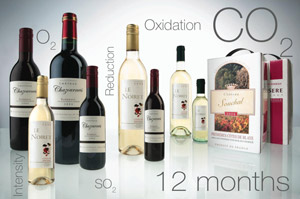PET WINE PACKAGING
French study asserts that white wine in PET bottles starts to oxidise within six months / Red wine unaffected / Further analysis in September
White wine starts to oxidise after six months of being stored in single- and multi-layer PET bottles, as well as bag-in-box, whereas red wine remains unaffected over the same period of time. Neither wine changes quality when stored in glass bottles. These are the main conclusions from a study being carried out by the Institut des Sciences de la Vigne et du Vin (ISVV, Villenave d’Ornan, Bordeaux / France; www.isw.fr) to determine the legitimacy of the packaging options for wine. The three-year study, which began in May 2008, is evaluating the influence of packaging on the storage of wine using three key criteria: chemical analysis of gases (oxygen, carbon dioxide and sulphur dioxide), physical analysis of colour, and a sensory analysis by a group of tasters.
 |
ISVV lecturer Rémy Ghidossi said the study was being undertaken because of contradictory information that has been circulating about wine packaging in recent months. “It is now necessary to establish the truth,” he said. “Based on scientific information and quantitative data, to determine the legitimacy of each package, as its main function is to preserve the flavour and characteristics of its contents.”
For white wine, the study has found that bag-in-box, single-layer PET and small, multi-layer PET bottles allowed oxygen to penetrate after six months of storage, with a corresponding reduction in the carbon dioxide content. The sulphur dioxide level in all three types of packaging also dropped significantly, to a level that was too low to ensure the wine’s stability. The change in conditions meant the white wine was clearly oxidised, said ISVV, with the tasters unanimous that it tasted of rotten fruit. White wine stored in the glass bottles remained stable by contrast. Some signs of deterioration in red wine quality were also starting to emerge after six months, but the institute says it is too early to draw any definite conclusions. An 18-month analysis of both wines will be carried out in September.
The study’s results are likely to surprise high street retailers starting to use PET as a lightweight alternative to glass. Earlier this month UK retailer Marks & Spencer launched a range of 19 wines in mini 25cl multi-layer PET bottles, saying they were guaranteed to stay fresh for 12 months – see Plasteurope.com of 13.05.2010. Britain's Waitrose also has launched two wines in PET bottles recently, aiming at the outdoor summer market. Like M&S, it said the contents were guaranteed to stay fresh for at least 12 months.
e-Service:
ISVV study on the influence of packaging on wine preservation as a PDF document
For white wine, the study has found that bag-in-box, single-layer PET and small, multi-layer PET bottles allowed oxygen to penetrate after six months of storage, with a corresponding reduction in the carbon dioxide content. The sulphur dioxide level in all three types of packaging also dropped significantly, to a level that was too low to ensure the wine’s stability. The change in conditions meant the white wine was clearly oxidised, said ISVV, with the tasters unanimous that it tasted of rotten fruit. White wine stored in the glass bottles remained stable by contrast. Some signs of deterioration in red wine quality were also starting to emerge after six months, but the institute says it is too early to draw any definite conclusions. An 18-month analysis of both wines will be carried out in September.
The study’s results are likely to surprise high street retailers starting to use PET as a lightweight alternative to glass. Earlier this month UK retailer Marks & Spencer launched a range of 19 wines in mini 25cl multi-layer PET bottles, saying they were guaranteed to stay fresh for 12 months – see Plasteurope.com of 13.05.2010. Britain's Waitrose also has launched two wines in PET bottles recently, aiming at the outdoor summer market. Like M&S, it said the contents were guaranteed to stay fresh for at least 12 months.
e-Service:
ISVV study on the influence of packaging on wine preservation as a PDF document
20.05.2010 Plasteurope.com [216267]
Published on 20.05.2010
